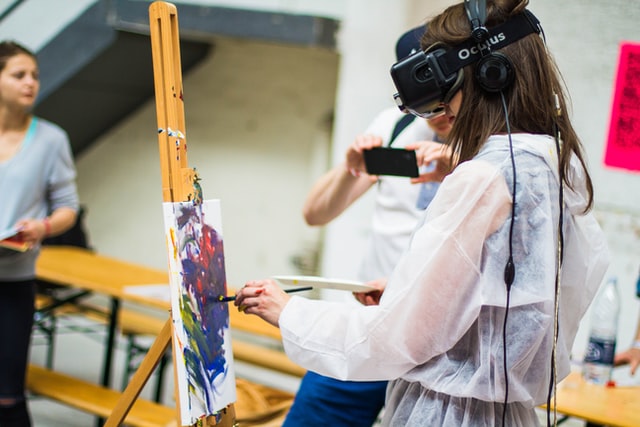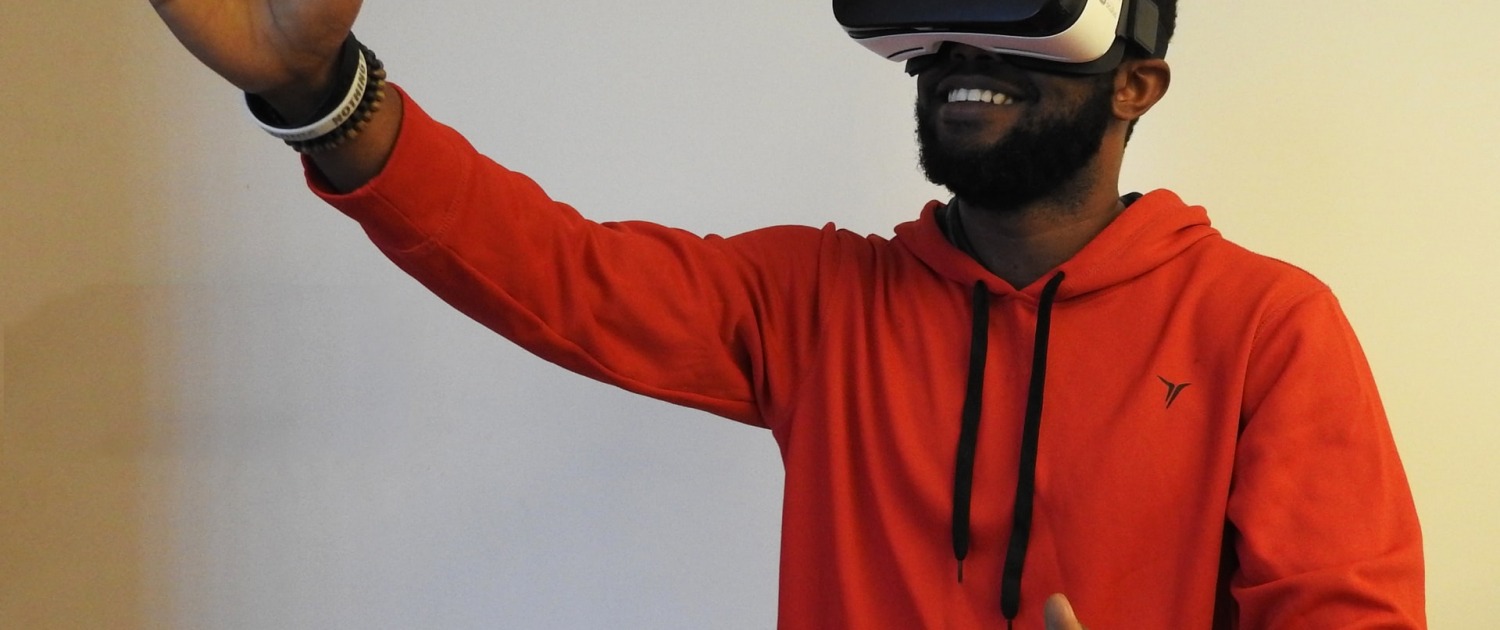How Does Virtual Reality Work? The Science, History & Applications Explained
Wondering how you ended up standing on top of some mountain or sailing in space while wearing a VR headset? Virtual reality is like magic, but in reality, it is a complex combination of hardware, software, and human perception coming together to deliver seamless virtual experiences.
The Evolution of Virtual Reality: Not Just a Modern Marvel
We believe that VR was invented recently, but its evolution is years older. Flight simulators in the 1950s gave the pilots an impression of what nowadays we call virtual reality—to have realistic settings to practice without endangering real flight.
The real breakthrough came in 1968, though, when computer science student Bob Sproull and his professor Ivan Sutherland created “The Sword of Damocles,” the first head-mounted display for virtual reality. Clumsy and crude by today’s standards, this pioneering device added head-tracking and stereoscopic views—the cornerstones employed to this day in virtual reality.
Remember those bulky VR gaming pods in arcades during the ’80s and ’90s? Systems like Virtuality introduced many of us to immersive gaming, despite their limitations in graphics and responsiveness. But it wasn’t until computing power caught up with creative vision that VR truly began to flourish. Modern VR arcade games build on that foundation, offering fully immersive experiences that blend cutting-edge visuals, motion tracking, and interactive storytelling.

Under the Hood: How Modern VR Creates Digital Worlds
Current VR devices are wonders of technology, integrating a number of technologies to fool our brains into believing digital worlds are real:
The Headset Experience
Contemporary VR headsets such as the Oculus Quest 3, HTC Vive Pro, and PlayStation VR2 feature high-resolution screens that present somewhat different images to each eye. This stereoscopic technique simulates how our eyes usually see depth, producing a sense of three-dimensional space.
Movement That Matters
What do you experience when you glance up at a virtual sky or turn to meet a digital friend? Motion tracking systems—externally mounted sensors, internally mounted cameras, and gyroscopes—detect these movements in real time. The VR world responds in an instant, keeping the illusion alive that you’re really somewhere else.
Sounds From All Sides
Shut your eyes in a quality VR experience and you can still sense where things are taking place. That’s spatial audio doing its magic—sound engineered to emanate from certain directions, just as it does in real life. When you get footsteps behind you in VR, your brain interprets that data exactly as it would in the real world.
The Touch of Digital Reality
Haptic suits and modern controllers provide an additional level of immersion via touch. When you pick up an object in VR, resistance and subtle vibrations can mimic weight and texture. Although we’re far from ideal tactile feedback, these technologies are improving rapidly.
Building Realistic Worlds
Some of the most breathtaking VR experiences use photogrammetry—constructing 3D models from images of real-world places. This technique allows creators to reimagine anything from ancient ruins to modern cities with stunning accuracy, so you can visit places you might never have seen in the real world.
Beyond Gaming: VR’s Real-World Impact
Though gaming gets most of the attention, virtual reality is transforming many aspects:
Revolutionizing Education
VR turns abstract concepts into tangible experiences. Biology students can walk through the human circulatory system. History classes can witness the signing of the Declaration of Independence. Geography lessons can include visits to the Amazon rainforest or the summit of Mount Everest.
For schools with limited resources, VR democratizes access to educational experiences. A classroom in rural America can “visit” the Louvre or explore coral reefs without expensive field trips.
Training in Hazardous Professions
Some professional trainings are hazardous or too costly. VR solution:
Risk-Free Medical Training
Surgical residents can now practice complex procedures any number of times inside of VR before ever touching a patient. They can make mistakes, learn from them, and perfect their techniques in a consequence-free environment.
Emergency Response Training
Firefighters, paramedics, and emergency response units use VR to set up crisis scenarios that are not safe or impossible to recreate during live training. They are able to practice making decisions in stress without putting anyone at risk.
Healthcare Breakthroughs
The therapeutic applications of VR keep expanding:
Beating Phobias and Anxiety
For a person who fears heights, gradual exposure therapy in VR enables them to stand on increasingly higher virtual ledges without ever having to leave their physical safety. This method has proven to be extremely effective in treating phobias, PTSD, and anxiety disorders.
Rediscovering Movement
Stroke rehabilitation patients usually get bogged down in repetitive exercises. VR turns these into fun games, making them more motivating and possibly speeding up recovery. Patients are concentrating on the virtual activity instead of the physical challenge, and usually with better success.
Changing Remote Work and Collaboration
The weaknesses of video calls reveal themselves when dealing with complicated collaborative work. VR presents different strategies:
More Than Just Meetings
Architects can walk clients through building blueprints before they are built. Groups of engineers can critique 3D models together from opposite ends of the world. Designers can work on three-dimensional objects in shared virtual studios.
Rapid Prototyping
Car manufacturers use VR to test designs without building models for each iteration. This approach saves amazing amounts of time and money while allowing more creative freedom.
The Road Ahead: VR’s Expanding Horizons
What’s ahead for virtual reality? A number of trends suggest exhilarating developments:
More and More Realistic Experiences
As processing power increases and developers become more skilled at their craft, the distinction between virtual and real reality keeps getting closer. Next-generation VR may immerse all the senses so realistically that it’s really hard to tell the difference between virtual and real experiences.
VR for All
Early virtual reality equipment required expensive computers and complex setup processes. Self-contained headsets like the current Quest 3 are bringing high-quality VR within reach of more consumers than ever before. As prices fall and user-friendliness increases, VR franchises and personal uses will grow increasingly mainstream.
Blending Realities
The lines between virtual reality and augmented reality are blurring into mixed reality, where digital and physical elements interact seamlessly. This technology could transform everything from how we shop to how we design our living spaces.
Virtual Communities
As social VR, we begin to glimpse the birth of virtual communities where people come together, collaborate, and share experiences with a collective anywhere in the globe. In due course, these virtual spaces could join the fray as crucial hubs of our social lives, just like physical spaces.
Where VR Is Taking Us Next
From its experimental beginnings to the sophisticated systems of today, virtual reality has dramatically changed over decades. Combining advanced computing, realistic rendering, and multisensory feedback, modern VR makes experiences that were once the stuff of science fiction come into being.
As the technology becomes accessible, and uses grow far beyond entertainment, it will transform our learning, work, healing, and our interaction with one another. This is just the journey from the very first flight simulator to the very immersive world today; more fascinating chapters in the book of virtual reality are being written.
For those interested in bringing immersive experiences to their communities, owning a VR business can be a way to lead that transformation.

